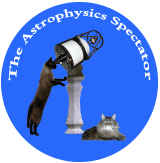| Latest Commentary | New Background | New Research |

October 13, 2004
With this second issue of The Astrophysics Spectator, I start our exploration of current scientific research with articles about gravitational waves and gravitational wave detectors. Gravitational waves are a feature of General Relativity, and indirect evidence of their existence is provided by the observed orbital decay of two different binary pulsars. All attempts to detect them directly, however, have failed. With new experiments now in operation and in the development stage, there is the chance that gravitational waves will be observed for the first time within the next-two decades. So, what are gravitational waves, what produces them, how can they be detects, and what value are they to the astronomical community? These questions are answered by the new background and research pages of this issue.
Jim Brainerd
Commentary
The Nature of the Unknown (October 13, 2004). Many projects in modern astrophysics is so expensive that only governments can fund them. NASA's great observatories cost between half and two billion dollars to build and launch. Gravitational wave facilities run over a hundred million dollars to build and tens of millions of dollars every year to operate. At these prices, the temptation to overpromise is strong. If Columbus were writing a proposal today for his voyage west to the Far East, would he list seeing sea monsters as one of his goals? (continue)
New Background Paths
Gravitational Waves. In the theory of General Relativity, the dominant theory of gravity, energy can propagate through the vacuum as gravitational waves in a process that is similar to the propagation of electromagnetic waves. Close neutron-star binaries and black-hole binaries collapsing into single stars constitute one class of astronomical event that should produce massive amounts of gravitational radiation. The observed orbital decay of two different binary pulsar systems, PSR1913+16 and PSR J0737-3039, suggests that gravitational radiation is removing energy from these systems; what we lack is the direct detection of gravitational waves arriving at Earth. If we can build an instrument to detect them, we would have a way of directly observing for the first time massive objects under the influence of strong gravitational fields. (continue)
New Current Research Paths
Michelson Interferometer Gravitational Wave Detectors. How does one detect gravitational radiation? One way is to suspend several weights and see if the distances between them changes. If one can measure changes as small as 10-16 cm, then one should be able to detect gravitational waves. Can we do it? Yes we can (if you give us enough money)! With a device called a Michelson interferometer, one can measure very fine changes in the separation of suspended weights. Several such ground based instruments have been built, and several more are in the development stages, including one based in space. With some luck, gravitational waves will be observed some time in the next-two decades, opening a new observational window onto the universe. (continue)

RSS Channel